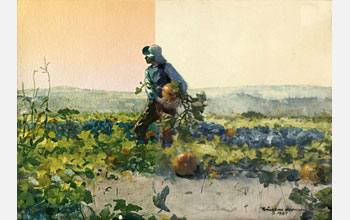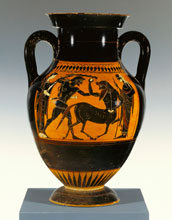For my latest art news, I visited the website of the National Science Foundation. Yes, there for another reason, I discovered three recent news items dealing with museums and conservation, and the findings made possible by science.
 The latest involves two paintings at the Art Institute of Chicago: Winslow Homer’s For to Be a Farmer’s Boy (a watercolor made in 1887) and van Gogh’s The Bedroom (1889). Using new techniques on the Homer, scientists now know for sure that the sky — “starkly blank” now — was once “a vibrant autumn sunset, with organic purples and reds, in addition to inorganic reds and yellows.”
The latest involves two paintings at the Art Institute of Chicago: Winslow Homer’s For to Be a Farmer’s Boy (a watercolor made in 1887) and van Gogh’s The Bedroom (1889). Using new techniques on the Homer, scientists now know for sure that the sky — “starkly blank” now — was once “a vibrant autumn sunset, with organic purples and reds, in addition to inorganic reds and yellows.”
The photo at left shows what a “restored” half would look like, and what the painting now looks like on the right.
The new discovery method is too involved for me to explain here, but it pairs a 30-year-old technique called Surface Enhanced Raman Spectroscopy with nanotechnology. Next up is using “these next-generation nanoparticles …to unlock information on dyes, pigments and binding media, as present in Van Gogh’s The Bedroom.” You can read the whole NSF article here.
 In another instance, the Metropolitan Museum of Art* is using new anti-body based research to “uncover the material world of art–the organic compounds mixed with inorganic materials that compose what we see in a painting, a sculpture or even costumes.” Discoveries were not disclosed so there may not be any — yet. But read more here.
In another instance, the Metropolitan Museum of Art* is using new anti-body based research to “uncover the material world of art–the organic compounds mixed with inorganic materials that compose what we see in a painting, a sculpture or even costumes.” Discoveries were not disclosed so there may not be any — yet. But read more here.
Finally, NSF put out this intriguing notice about Attic pottery from 4th to 6th centuries B.C.:
…a collaborative group of California scientists from the Getty Conservation Institute (GCI), the Aerospace Corporation and the Department of Energy’s SLAC National Accelerator Laboratory (SLAC) at Stanford is investigating the ancient technology used to create these works of art. From their study of the makeup of this iconic pottery, the researchers hope to further current conservation practice and future space travel….
Led by Karen Trentelman, a conservation scientist at the GCI, the grant team is working with conservators and curators from the J. Paul Getty Museum to attribute characteristic material “signatures” to known artists, which should aid the classification of unsigned works. The information will provide a deeper understanding of ancient pottery techniques and inform future conservation methods.
Of importance to aerospace industries, the effort will also create a deeper knowledge of iron-spinel chemistry, which is critical for advanced ceramics found in aerospace applications.
Many more details and descriptions are here. Finding “signatures” and making attributions to works that are currently “artist not known” would be great fun, akin to the work attributing Native American works that I wrote about here.
Indeed, that’s what ran through my mind reading about these conservation techniques: they hold other promises for art research, too.
I’m not sure how competitive these NSF grants are, but here’s a link to the NSF’s Chemistry and Materials Research in Cultural Heritage Science program.
Photo Credits: © Kristi Dahm, Loren McDonald, The Art Institute of Chicago (top); J. Paul Getty Museum (bottom)
*I consult to a Foundation that supports the Met
